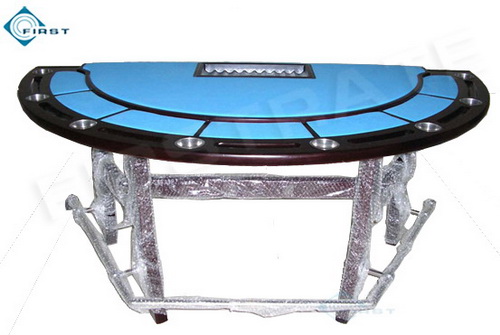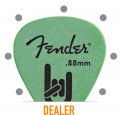In a previous life I used to do some writing about about industrial design, product design, that kind of thing. These articles often focused on ergonomics and usability: Did the product’s shape, size materials actually contribute to it working as advertised?
So: In my opinion, the shapes of standard poker tables make no sense.
The standard “stadium” shaped table is a disaster, from a usability standpoint. If you’re seated on the rounded corners in a self-dealt game, it’s a giant pain in the neck to deal. To really see the player next to you, you have to turn way too far to the side.
When there is a dealer cut-in on a stadium table, the dealer blocks seat 9 (and 10, in some tournaments) from seeing much of anything going on in seats 1 and sometimes 2, and vice-versa.
Frankly, I’d rather play 8-handed on a round resin table in a self-dealt firehouse game than 10-handed at a casino stadium table. At least you can see everyone.
The WSOP final tables, I notice, are different. So they know the stadium shape is a problem. They are shaped more like a kidney bean (on the convex side) and flat on the other side where the dealer is. Such tables are also used on shows like Poker After Dark or other games where (a) the camera doesn’t want to have to pan all the way around the table and (b) there are usually only 6-7 players.
And don’t get me started on the problem at so many casinos (and some home games) of leg room at their tables.
I have started doing some thinking and (draft) writing on this topic, and considering what the true ideal shape would be. We take stadium tables for granted, but really, why should we? For that matter, why should we even take 9-handed games for granted? This really seems to be a convention of the modern era of Hold ’Em. (No one was playing 7-card stud 9-handed, right?) And it mainly seems to be driven by casinos wanting to cram as many people as they can in per table.
Sorry for the rant, but this topic is much on my mind now, and I’d love to get some feedback. Do people share my aversion to these standard table shapes, or am I alone here? How do you feel about those octagon tables which were a common rec room item in the 60s and 70s? Maybe some totally different shapes should be considered (though they would be a little trickier to build in the garage).
Thanks for reading this far, if anyone did...

So: In my opinion, the shapes of standard poker tables make no sense.
The standard “stadium” shaped table is a disaster, from a usability standpoint. If you’re seated on the rounded corners in a self-dealt game, it’s a giant pain in the neck to deal. To really see the player next to you, you have to turn way too far to the side.
When there is a dealer cut-in on a stadium table, the dealer blocks seat 9 (and 10, in some tournaments) from seeing much of anything going on in seats 1 and sometimes 2, and vice-versa.
Frankly, I’d rather play 8-handed on a round resin table in a self-dealt firehouse game than 10-handed at a casino stadium table. At least you can see everyone.
The WSOP final tables, I notice, are different. So they know the stadium shape is a problem. They are shaped more like a kidney bean (on the convex side) and flat on the other side where the dealer is. Such tables are also used on shows like Poker After Dark or other games where (a) the camera doesn’t want to have to pan all the way around the table and (b) there are usually only 6-7 players.
And don’t get me started on the problem at so many casinos (and some home games) of leg room at their tables.
I have started doing some thinking and (draft) writing on this topic, and considering what the true ideal shape would be. We take stadium tables for granted, but really, why should we? For that matter, why should we even take 9-handed games for granted? This really seems to be a convention of the modern era of Hold ’Em. (No one was playing 7-card stud 9-handed, right?) And it mainly seems to be driven by casinos wanting to cram as many people as they can in per table.
Sorry for the rant, but this topic is much on my mind now, and I’d love to get some feedback. Do people share my aversion to these standard table shapes, or am I alone here? How do you feel about those octagon tables which were a common rec room item in the 60s and 70s? Maybe some totally different shapes should be considered (though they would be a little trickier to build in the garage).
Thanks for reading this far, if anyone did...





